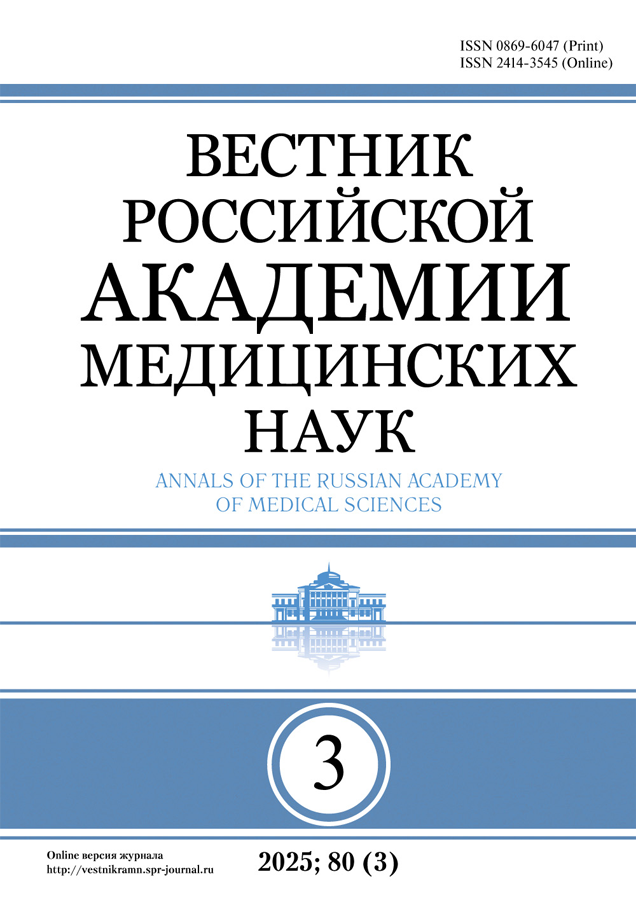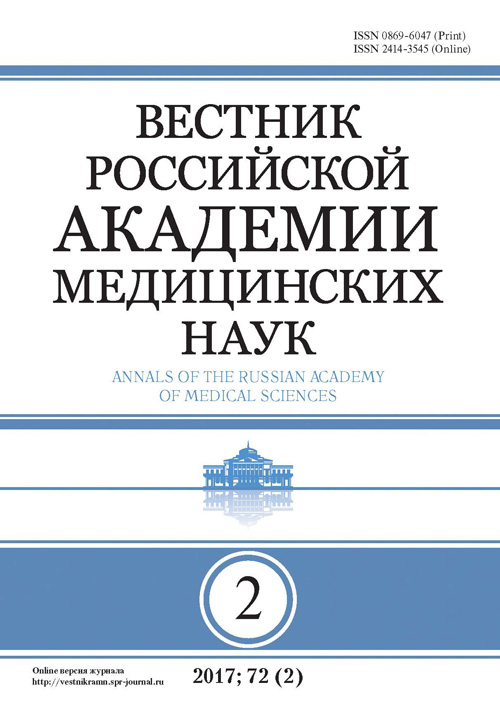СРАВНИТЕЛЬНОЕ ИССЛЕДОВАНИЕ КОЛИЧЕСТВЕННОГО И ВИДОВОГО СОСТАВА ДРОЖЖЕПОДОБНЫХ ГРИБОВ РОДА CANDIDA У БОЛЬНЫХ ХРОНИЧЕСКИМ ГЕНЕРАЛИЗОВАННЫМ ПАРОДОНТИТОМ РАЗНОЙ СТЕПЕНИ ТЯЖЕСТИ
- Авторы: Волченкова Г.В.1, Кирюшенкова С.В.1, Николаев А.И.1, Шашмурина В.Р.1, Девликанова Л.И.1
-
Учреждения:
- Смоленский государственный медицинский университет
- Выпуск: Том 72, № 2 (2017)
- Страницы: 143-148
- Раздел: АКТУАЛЬНЫЕ ВОПРОСЫ СТОМАТОЛОГИИ
- Дата публикации: 28.02.2017
- URL: https://vestnikramn.spr-journal.ru/jour/article/view/770
- DOI: https://doi.org/10.15690/vramn770
- ID: 770
Цитировать
Полный текст
Аннотация
Обоснование. Пародонтит является главной причиной потери зубов у людей средней и старшей возрастных групп, что требует повышенного внимания исследователей к проблеме этиологии, патогенеза, диагностики и терапии данного заболевания. В настоящее время взаимодействие микробного содержимого зубной бляшки и локального тканевого ответа на нее рассматривается в качестве основной причины развития воспалительных заболеваний пародонта. Вместе с тем отечественные и зарубежные исследователи отмечают высокую частоту так называемых торпидных, или устойчивых, к антимикробной терапии форм пародонтита.
Цель: изучить видовой и количественный состав грибов рода Candida в содержимом пародонтальных карманов у больных с разной степенью тяжести хронического генерализованного пародонтита.
Методы. Проведено нерандомизированное неконтролируемое ретроспективное исследование, в ходе которого изучены основные клинико-рентгенологические показатели состояния пародонта и его обсемененность грибами рода Candida у людей с легкой, средней и тяжелой степенью хронического пародонтита.
Результаты. Из 82 участников исследования сформированы четыре группы, три из которых составили больные хроническим генерализованным пародонтитом легкой, средней и тяжелой степени; четвертая группа пациентов ― без признаков заболеваний пародонта. У обследованных контрольной группы частота выделения грибов рода Candida из содержимого десневой борозды составила 9,09%, у больных с патологией пародонта из пародонтальных карманов ― 64,91%. Высокая обсемененность грибковой флорой (>6,0 КОЕ/мл) наблюдалась у всех больных хроническим пародонтитом. Всего выделено 40 штаммов Candida с преобладанием Candida albicans.
Заключение. В результате проведенного исследования получены данные об увеличении обсемененности пародонта грибами рода Candida у больных пародонтитом по сравнению со здоровыми людьми. Предполагаем, что наличие грибов рода Candida в пародонтальном кармане может рассматриваться и в качестве возможной составляющей этиологии хронического пародонтита, и как фактор, усугубляющий его течение. Дальнейшие исследования могут быть направлены на определение целесообразности и эффективности введения в комплексную терапию хронического пародонтита противогрибковых препаратов.
Ключевые слова
Об авторах
Галина Валентиновна Волченкова
Смоленский государственный медицинский университет
Email: gvalentiv@gmail.com
ORCID iD: 0000-0002-1687-3645
http://smolgmu.ru/index.php?page[common]=user&id=53856
Кандидат медицинских наук, доцент кафедры стоматологии факультета дополнительного профессионального образования.
214019, Смоленск, ул. Крупской, д. 28.
SPIN-код: 1355-6097
РоссияСветлана Владимировна Кирюшенкова
Смоленский государственный медицинский университет
Email: svet-kiryusha@mail.ru
ORCID iD: 0000-0002-9687-2107
http://smolgmu.ru/index.php?page[common]=user&id=53652
Кандидат медицинских наук, доцент кафедры микробиологии.
214019, Смоленск, ул. Крупской, д. 28.
SPIN-код: 9054-7316
РоссияАлександр Иванович Николаев
Смоленский государственный медицинский университет
Email: anicolaev@inbox.ru
ORCID iD: 0000-0002-1378-6538
http://smolgmu.ru/index.php?page[common]=user&id=53912
Доктор медицинских наук, профессор, заведующий кафедрой терапевтической стоматологии.
214019, Смоленск, ул. Крупской, д. 28.
SPIN-код: 2687-8206
РоссияВиктория Рудольфовна Шашмурина
Смоленский государственный медицинский университет
Автор, ответственный за переписку.
Email: shahmurina@yandex.ru
ORCID iD: 0000-0001-5216-7521
http://smolgmu.ru/index.php?page[common]=user&id=40872
Доктор медицинских наук, профессор, заведующая кафедрой стоматологии факультета дополнительного профессионального образования.
214019, Смоленск, ул. Крупской, д. 28.
SPIN-код: 4199-4204
РоссияЛилия Ильдаровна Девликанова
Смоленский государственный медицинский университет
Email: devlikanova.l@mail.ru
ORCID iD: 0000-0001-9367-6664
http://smolgmu.ru/index.php?page[common]=user&id=53857
Ассистент кафедры стоматологии факультета дополнительного профессионального образования.
214019, Смоленск, ул. Крупской, д. 28.
SPIN-код: 5421-7863
РоссияСписок литературы
- Грудянов А.И. Заболевания пародонта. ― М.: Медицинское информационное агентство. ― 2009. — 336 c. [Grudyanov AI. Zabolevaniya parodonta. Moscow: Meditsinskoe informatsionnoe agentstvo; 2009. 336 p. (In Russ).]
- Цепов Л.М., Голева Н.А. Роль микрофлоры в возникновении воспалительных заболеваний пародонта // Пародонтология. ― 2009. ― №1 ― С. 7–12. [Tsepov LM, Goleva NA. Role of microbial flora in the development of inflammatory periodontal diseases. Parodontologiya. 2009;(1):7–12. (In Russ).]
- Островская Л.Ю., Бейбулатов Г.Д., Лепилин А.В. Факторы, влияющие на развитие кандида-ассоциированного пародонтита // Российский стоматологический журнал. ― 2014. ― №4 ― С. 36–38. [Ostrovskaya LY, Beybulatov GD, Lepilin AV. Factors of influencing candida-associated periodontal disease development. Rossiiskii stomatologicheskii zhurnal. 2014;(4):36−38. (In Russ).]
- Чепуркова O.A. Кандида-ассоциированный пародонтит. Диагностика. Лечение: Автореф. дис. … докт. мед. наук. ― Омск; 2010. — 37 с. [Chepurkova OA. Kandida-assotsiirovannyi parodontit. Diagnostika. Lechenie. [dissertation abstract] Omsk; 2010. 37 p. (In Russ).]
- Чепуркова О.А. Прогнозирование степени обсемененности пародонтальных карманов дрожжеподобными грибами рода Candida spp. у пациентов с хроническим генерализованным пародонтитом при различных факторах риска (часть I) // Институт стоматологии. ― 2009. ― Т.1. — №42 ― С. 78–79. [Chepurkova OA. Prognozirovanie stepeni obsemenennosti parodontal’nykh karmanov drozhzhepodobnymi gribami roda Candida Spp. u patsientov s khronicheskim generalizovannym parodontitom pri razlichnykh faktorakh riska (chast’ I). Institut stomatologii. 2009;1(42):78−79. (In Russ).]
- Комлева А.С. Оптимизация консервативного лечения больных хроническим генерализованным пародонтитом, ассоциированным с кандида-флорой: Автореф. дисс... канд. мед. наук. ― Омск; 2010. — 22 с. [Komleva A.S. Optimizatsiya konservativnogo lecheniya bol’nykh khronicheskim generalizovannym parodontitom, assotsiirovannym s kandida-floroi. [dissertation abstract] Omsk; 2010. 22 p. (In Russ).]
- Царев В.Н., Носик А.С., Сударикова С.А., Мезенцева Н.А. Принципы современной клинико-лабораторной диагностики инвазивной кандидозной инфекции // Стоматолог. ― 2010. ― №3 ― С. 46−52. [Tsarev VN, Nosik AS, Sudarikova SA, Mezentseva NA. Printsipy sovremennoi kliniko-laboratornoi diagnostiki invazivnoi kandidoznoi infektsii. Stomatolog. 2010;(3):46−52. (In Russ).]
- Мелехов С.В. Роль дрожжеподобных грибов рода Candida в развитии патологии пародонта // Маэстро стоматологии. ― 2007. ― №2 ― С. 72–75. [Melekhov SV. Rol’ drozhzhepodobnykh gribov roda Candida v razvitii patologii parodonta. Maestro stomatologii. 2007;(2):72–75. (In Russ).]
- Пародонтология. Национальное руководство / Под ред. Л.А. Дмитриевой. ― М.: Наука; 2013. — 712 с. [Parodontologiya: natsional’noe rukovodstvo. Ed by Dmitrieva L.A. Moscow: Nauka; 2013. 712 p. (In Russ.)]
- Микробиология, вирусология и иммунология. Учебник для студентов мед. вузов / Под ред. В.Н. Царева. ― М.: Практическая медицина; 2009. — 581 с. [Mikrobiologiya, virusologiya i immunologiya: uchebnik dlya studentov med. vuzov. Ed by Tsarev V.N. Moscow: Prakticheskaya meditsina; 2009. (In Russ).]
- Суркова С.А. Особенности клинико-лабораторной диагностики инвазивной кандидозной инфекции слизистой оболочки полости рта // Dental Forum. ― 2012. ― №3 ― С. 94. [Surkova SA. Osobennosti klinikolaboratornoi diagnostiki invazivnoi kandidoznoi infektsii slizistoi obolochki polosti rta. Dental Forum. 2012;(3):94. (In Russ).]
Дополнительные файлы








